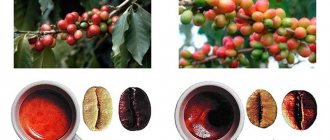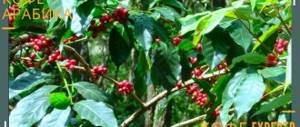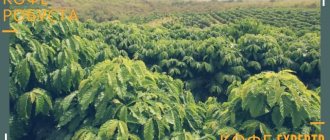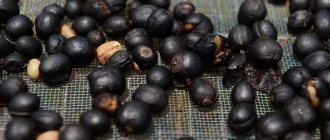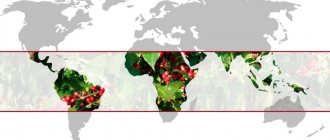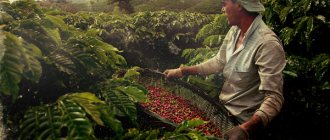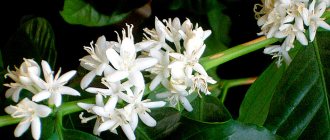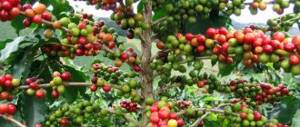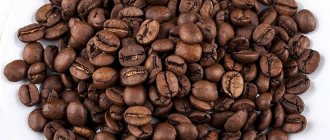What are Arabica and Robusta
Arabica and Robusta are evergreen coffee trees belonging to the coffee genus of the Rubiaceae family. The trees grow in equatorial climates, mainly in Africa, Asia, Central and South America. Arabica was born as a result of a natural crossing of two types of coffee: Eugenioides and Robusta. Yes, Robusta is the parent of Arabica. Details of their relationship, who appeared, how and where, can be found in our articles about Arabica and Robusta, and we will move on to the essence of the article.
Arabica and Robusta
The main thing you need to know is that concepts such as variety and species are often confused. There are many types of coffee. They are mainly obtained by mixing Arabica and Robusta in different consistencies. Or used in its pure form.
There are much fewer types of coffee. About 90% of them are Arabica and Robusta, belonging to the same group of plants from the genus Coffee (Coffea) from the extensive Rubiaceae family. They differ in their growing climate, appearance, and ripening time. The size of the grains, and the taste and chemical composition. And as a result, this is reflected in the quality of the finished drink, strength and aroma. So:
Basic historical facts
- Place of discovery: The first mentions of Arabica were in Ethiopia, and Robusta in Uganda.
- Places of growth: Arabica is cultivated in America, Africa, Asia, the Caribbean and Oceania. Robusta is mainly cultivated on an industrial scale in Asia and Africa.
- Leader in production: Leader in Arabica production - Brazil, Robusta - Vietnam.
- Share in world production: 70% of the world volume belongs to Arabica, 30% to Robusta.
- Characteristics of the coffee tree
- Tree height: Arabica can grow up to 10 meters, robusta up to 15 meters.
- Growing altitude: Arabica grows from 900 to 2500 meters above sea level, robusta grows lower, from 200 to 900 meters.
- Resistance to parasites and diseases: Arabica is less resistant to diseases, robusta, on the contrary, has high resistance to parasites and diseases.
Bean price
It is difficult to give a definite answer regarding the price of both varieties. Most often, Arabica costs twice as much as Robusta. The cost depends on the effort spent on growing a particular variety, as well as on the taste of the resulting coffee. Arabica requires more careful care, but at the same time has a higher taste. Robusta usually costs less: it is unpretentious to grow, but its taste is much harsher. However, you should not determine the type of coffee based on its cost: sometimes sellers can price Robusta more expensive than Arabica, since the quality of the crop is much higher. Raw materials and their quality can significantly affect the final cost of coffee.
Is Robusta really inferior to Arabica?
In general, Robusta is considered the worst coffee. And Arabica beans are noble and aromatic. This overall verdict is due to the Robusta variety being used for its cheaper price rather than for cheaper coffee. But this point of view is unjustified: there are also very good qualities of Robusta and rather average Arabica beans. The growing area as well as the firing process and degree are of decisive importance. For example, robusta beans are highly prized in Italy and can be found in many blends. Robusta beans are responsible for the cream in espresso.
Characteristics of coffee beans
- Bean shape: Arabica has a more elongated shape, Robusta is more round.
- Caffeine content: Arabica has half the caffeine content, 1-1.5%, than Robusta, 2-3%.
- Content of essential oils: Robusta contains half as much essential oils (8%) as Arabica (18%).
- Sugar content: Robusta contains two times less sugars (5%) than Arabica (8%).

Taste and aroma
These two varieties have completely different taste characteristics. Arabica is considered a softer drink that is practically not bitter. Robusta is much coarser than its counterpart, but in some varieties you can feel other notes of taste.
Sweetness
Sweet notes are, in principle, not characteristic of any type of coffee. Only some varieties may contain such notes: Indian Robusta (you can feel the nutty-chocolate flavor), Yemeni Arabica (chocolate flavor), etc.
Kislinka
The sourness is characteristic of the Arabica variety, since Robusta practically does not carry this shade, with the exception of the Indian version. Wine sourness can be felt in the Mayosor variety, and the berry aftertaste is characteristic of Guatemelian Arabica.
Bitterness
Arabica is practically not bitter - this property is more typical of robusta. This type of coffee is generally harsher in taste. There are small exceptions in this case: in Zambian Arabica you can feel a slight bitterness.
Size and appearance
The appearance of Robusta and Arabica is also very different from each other. However, if you know their main distinguishing features, then determining what exactly is in front of you will not be difficult.
- Arabica has oval-shaped grains, the size of which is about 7-8 mm. After the beans are roasted, they become uniformly brown in color.
- Robusta grains are more rounded and smaller in shape - their size is no more than 6 mm. After roasting, a large number of brown shades appear on the beans, so even after processing it is not difficult to distinguish between these two varieties.
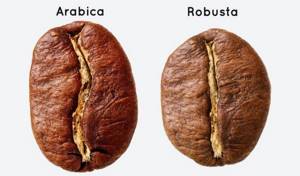
Popular varieties
To put it correctly, Arabica is not a variety of coffee, but a type of coffee plant. Therefore, it is divided into a large number of varieties: Typica, Bali, Bourbon, Katura, Aramosa, Shinzan, etc. Each version of this coffee has its own specific features and aroma. Arabica is a classic type of coffee, which is why there are so many varieties based on it. Robusta does not boast as many varieties: these include Quilu, Ambry and Conillon du Brasil.
Which coffee is stronger?
The main difference is that Robusta contains more caffeine than Arabica (3% and 1.5%).
This fact influences the preferences of coffee consumers. Due to the low concentration of the alkaloid, A has a mild taste and has a more gentle effect on the body.
Robusta is characterized by astringency and increased strength, so it is recommended to be used in various combinations with Arabica.
According to experts, the strength of robusta is due to the high resistance of the plant, its ability to withstand climate change and disease.
Unlike Arabica, Robusta has a high level of tannins, which imparts bitterness. But this detail is responsible for the formation of a denser foam, which cannot be achieved by preparing Arabica in its pure form.
Important! The combination of both types of coffee in different proportions is a unique find that expands the palette of tastes.
Areas and purposes of application
- In espresso coffee blends: Arabica is added for acidity, sweetness and aroma. Robusta for bitterness, density, strength and creams.
- In single-origin coffee: Arabica is suitable for those who like more acidic and aromatic coffee. Robusta is for those who like it stronger and appreciate bitterness in taste.
- In instant coffee: Mostly the cheapest, low quality coffee and Arabica and Robusta are used.
- In flavored coffee: Often the cheapest coffee is used, but sometimes more expensive items are flavored, both Arabica and Robusta.
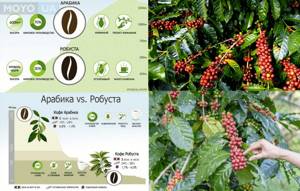
What is the difference between Arabica and Robusta
Arabica and Robusta have many differences in aspects such as taste, acidity, cultivation and harvesting.
Arabica
Coffee made from Arabica beans is considered to be of higher quality than Robusta coffee. This is mainly due to its subtle acid profile and lower caffeine content. The aroma of Arabica beans is usually slightly sweet, sometimes chocolatey, sometimes fruity. Individual tastes vary greatly and depend on the growing area. Sensitive Arabica, also known as java or mountain coffee, grows in high altitudes between 600 and 2000 meters, but is preferably grown in areas above 1000 meters. Because in the highlands the coffee cherry grows very slowly and acquires its typical wonderful taste.
Why is it considered that Robusta is worse than Arabica?
Among coffee lovers you can often hear the opinion that Robusta is much worse than Arabica, which means it is almost impossible to drink. In fact, the reasons for this stereotype are several factors:
- Robusta cannot offer such a variety of flavors and varieties, unlike Arabica;
- Huge difference in price: Arabica usually costs twice as much as Robusta;
- Conditions for growing varieties: usually they don’t spend a lot of time and effort on Robusta, so the quality of coffee can be much lower than that of Arabica.
Arabica and Robusta. Differences, reviews
People who are well versed in coffee can easily distinguish any beans from each other by color, shape, smell, depending on where the coffee grew. But we shouldn’t go into such details, because for the most part we are just lovers of this wonderful drink. There is enough information for us that the combination of several types of coffee beans in one mixture gives us the unique taste of our favorite drink.
Some people prefer Robusta. Others claim to be crazy about the taste of Arabica. Therefore, each person has his own preferences, and not only in the choice of coffee.
Which is better Arabica or Robusta
Only one person can answer this question, you will find him in the mirror. After all, taste is a very subjective thing, everyone has their own. For one, green apples will be sour, but for another, on the contrary, just right. Therefore, you can only get to the bottom of your truth through trial and error. The only thing is, choose a good supplier, not store-bought coffee, but a company that roasts it itself, knows what’s inside its pack, will tell you about the coffee and help with the choice. It is important.
Summary table of differences between Arabica and Robusta
To summarize our comparison of the two varieties, let’s record all the distinctive features in a table.
| Arabica | Robusta | |
| Homeland of origin | Ethiopia | Congo River Basin |
| Share of coffee variety in the world market | 75% | 25% |
| Features of care and cultivation | It grows at altitudes of 800-2200 meters above sea level, requires special care, as it is vulnerable to diseases and negative environmental influences | It grows in valleys and at altitudes up to 600 meters above sea level. It does not require much effort to care for and has its own protection against diseases. |
| Pollination method | Cross | Self-pollination |
| Appearance of coffee | The grains are oval in shape, up to 8 mm in size. After frying, the brown color is distributed evenly | Round bean shape, uneven color after the roasting process, small size. |
| Taste | Several types of varieties with different tastes: mostly soft, with sourness | Hard taste with slight bitterness |
| Aroma | Strong and pleasant | Subtle |
| Fortress | Medium, low | High level |
| Price | It costs more than robusta because it requires more resources to grow. | Arabica is twice as cheap. |
Arabica and Robusta - eternal rivals
Tasters around the world recognize the fact that these 2 varieties are eternal rivals. Experts also believe that Arabica beans are of better quality than their competitors. To understand the difference, it is necessary to conduct a detailed comparison of Arabica and Robusta varieties
Composition: Arabica and Robusta
Arabica beans include the following components: • Aromatic elements – about 18%; • Proteins – 13%; • Sugar – 8%, frying reduces its content to 3%; • Caffeine up to 2%. After heat treatment, its content is reduced to 1.3%. Robusta contains 2 times more caffeine, with significantly less aromatic oils, only 8%.
Taste qualities of Arabica and Robusta
Robusta has a rich structure, which gives it viscosity. This quality is successfully used for making espresso. It is the viscosity that allows the formation of a persistent, fluffy foam on the drink, which is called “cream”. That's why professionals use exclusively robusta to make espresso. Arabica is a variety with refined taste. The characteristic sourness is the result of a high concentration of amino acids in the grains. Unlike Robusta, Arabica has no viscosity. Experts note the refined taste and unique aroma of this type of coffee. These qualities are laid down at the grain processing stage. For this, a wet method is used, while robusta is processed using dry technology.
Cost of Arabica and Robusta
In this category, the clear leader is Arabica, which is more expensive than Robusta. At the same time, Arabica occupies 70% of the world coffee market. The cost of a variety is affected not only by the yield indicator, but by the technology used for its processing. In the case of Arabica beans, the wet method is used, which is more expensive than the dry method. Robusta is highly resistant to various diseases, produces higher yields, and is processed using dry technology. The combination of these factors makes Robusta a relatively cheap variety.
Dry and wet processing technology
The dry method of processing coffee beans is the process of drying them in the open air. The fruits are first distributed in a thin, even layer on special areas under canopies. The grains must be stirred periodically over several days. In countries where the climatic feature is a high level of humidity, machines come to the rescue that complete the task in 2-3 days. Then the husk is separated. Special combines are also used for this, but high-quality grains go through manual processing. This prevents their mechanical damage. Wet processing begins by covering the coffee beans in large vats with a wet cloth. They are closed with airtight lids on top. After 8 hours, the pulp that has absorbed moisture is separated by special machines. The grains are then sent back to the vats where the fermentation process begins. It contributes to the appearance of a sweet taste and enhances the aroma. Next comes the process of separating the husks; for this purpose, the grains are poured into special drums. After completing this cycle, they are sent to drying, which lasts 2-3 days. At the final stage, the grains are sorted and packed into 50–60 kg bags.
What to choose: Arabica or Robusta
Selection of Arabica and Robusta. As we said earlier, delicious coffee is different for everyone, but we can only give a couple of recommendations for navigation when choosing your ideal cup:
All the recommendations given below are valid provided that the coffee is not heavily roasted, because if it is, then it doesn’t matter whether it’s Arabica or Robusta, everything will be the same: ashy and very bitter.

If you like more acidic coffee with a bright aroma, then try Arabica. Moreover, Arabica beans are also different; African beans will be more sour than, for example, those from Asia. As a rule, all roasters indicate the characteristics of each variety; look at them, this will help with your choice. Here, for example, is our assortment of Arabica beans.
- If you like your coffee stronger so that the bitterness dominates the taste, then try Robusta. Robusta is good coffee, it is popular, inexpensive, and those who “throw mud at it” are simply showing vanity. We roast only one variety of this coffee - Uganda Robusta.
- If you've read both of the previous points and think you need something in between, then take a look at espresso blends. Moreover, choose the one where the ratio of Arabica and Robusta seems optimal to you. We blend seven espresso blends with different percentages, which can satisfy the gastronomic needs of 99% of coffee lovers. At least that's what we think)
- If you read this article carefully, and not through a diagonal line, then you are more likely to know which coffee to choose.
But if you still have doubts, then write to us, we will help) See you soon.
